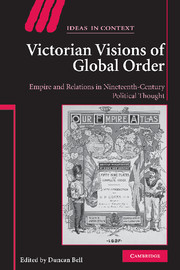 Victorian Visions of Global Order
Victorian Visions of Global Order Published online by Cambridge University Press: 22 September 2009
INTRODUCTION
Within the multiform and sometimes contradictory web of ideas labelled ‘liberalism’ in Victorian England there was an important strand of thinking best described as popular radicalism. It emerged in the eighteenth century, finding its first full expression in the work of Paine, and ended with Hobson and Brailsford in the early twentieth century, at which point it was subsumed in what passed in Britain for Marxism. In the grand narrative of radicalism the world was divided – to use James Mill's and Bentham's dramatic language – between the ‘Many’ and the ‘Few’. The Many were the carriers of freedom in religion, in politics and in the sphere of the market; the Few were the traditional autocratic elite who, through privilege and monopolies, controlled and exploited the Many. Until late in the nineteenth century the core of the Few was the landed class, but it also embraced a cluster of interests including the military, the established church, businesses dependent on aristocratic favour, the London professional and political elites and the key institutions of the City of London that had financed the revolution after 1688. The elite controlled the state and taxation and used it to drain the wealth of the ‘producing classes’ – small capitalists and workers alike – to further its own interests.
To save this book to your Kindle, first ensure no-reply@cambridge.org is added to your Approved Personal Document E-mail List under your Personal Document Settings on the Manage Your Content and Devices page of your Amazon account. Then enter the ‘name’ part of your Kindle email address below. Find out more about saving to your Kindle.
Note you can select to save to either the @free.kindle.com or @kindle.com variations. ‘@free.kindle.com’ emails are free but can only be saved to your device when it is connected to wi-fi. ‘@kindle.com’ emails can be delivered even when you are not connected to wi-fi, but note that service fees apply.
Find out more about the Kindle Personal Document Service.
To save content items to your account, please confirm that you agree to abide by our usage policies. If this is the first time you use this feature, you will be asked to authorise Cambridge Core to connect with your account. Find out more about saving content to Dropbox.
To save content items to your account, please confirm that you agree to abide by our usage policies. If this is the first time you use this feature, you will be asked to authorise Cambridge Core to connect with your account. Find out more about saving content to Google Drive.